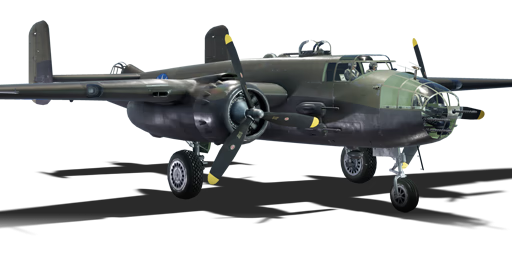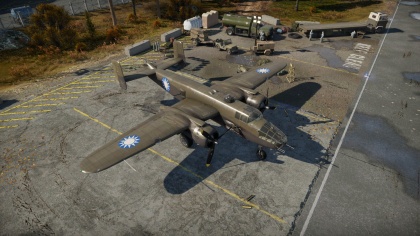B-25J-30 (China)
Contents
| This page is about the Chinese bomber B-25J-30 (China). For other versions, see B-25 (Family). |
Description
The ␗B-25J-30 Mitchell is a rank III Chinese bomber
with a battle rating of 4.0 (AB/RB) and 4.3 (SB). It was introduced in Update 1.91 "Night Vision".
Design of the B-25 was the result of years of work and failed bids to win contracts with the United States Army Air Corps (USAAC). Initially designed to meet requirements for a payload of 1,200 lb (540 kg), a range of 1,200 mi (1,900 km) and flying at speeds faster than 200 mph (320 kph), prototypes were built, tested and refined. Although the original XB-21 and NA-40 never materialized into a production aircraft, requirements from the USAAC came out in March of 1939 for a medium bomber carrying a payload of 2,400 lb (1,100 kg) over 1,200 mi (1,900 km) at speeds around 300 mph (480 kph), North American modified their design of NA-40 and developed the NA-62 which went into prototype testing as the YB-25 and then ordered into production as the B-25.
The B-25 turned out to be the archetype of the medium bomber, carrying upwards of 3,000 lb (1,361 kg) of bombs and could fly at speeds up to 340 mph (547 kph). This twin-engine bomber was fast, it could carry a large payload for its size and had several defensive turrets and gunner stations at which it could defend itself from almost any angle. To increase its versatility, several models had forward-facing fixed machine guns fitted into the nose and the cheeks of the aircraft. Later models opted to removed the glazed nose and bombardier/nose-gunner station and outfit more machine guns and even a 75 mm autocannon for strafing ground targets and especially ships. This medium bomber at times acted more like a heavy attacker opting for low-level flights which would skim treetops and the ocean to sneak up on unwary targets. It was not uncommon for B-25s to fly just above the mast/smokestack height of enemy ships when attacking.
As later models moved from the dedicated bomber position and morphed into more of an attacker role, bomb payloads were reduced to allow for more armour around the cockpit and more offensive weapons and ammunition to fill the attacker mode it took on, especially under the command of U.S. Marine Corps squadrons. With more than 10,000 B-25 aircraft variants built, they saw action in all theatres of war and were even subject to part of the lend-lease program which China and the USSR benefitted from. So versatile was this aircraft that a flight of them were specifically outfitted and their crews trained to take off from an aircraft carrier and bomb mainland Japan in a daring raid. Impressive for an aircraft not meant to take off from an aircraft carrier.
The B-25 is a fantastic bomber, attacker or both and will suit many different pilots and their different approaches to the battlefields found in War Thunder. The tail gunner has been known to set many fighters alight with their dual .50 calibre machine guns and help to prolong the life of this bomber to allow the pilot to make it to their target whether it is to bomb it or strafe it.
General info
Flight performance
Describe how the aircraft behaves in the air. Speed, manoeuvrability, acceleration and allowable loads - these are the most important characteristics of the vehicle.
| Characteristics | |||||||
|---|---|---|---|---|---|---|---|
| Stock | |||||||
| Max Speed (km/h at 3,049 m) |
Max altitude (meters) |
Turn time (seconds) |
Rate of climb (meters/second) |
Take-off run (meters) | |||
| AB | RB | AB | RB | AB | RB | ||
| ??? | ??? | 7500 | ??.? | ??.? | ??.? | ??.? | 750 |
| Upgraded | |||||||
| Max Speed (km/h at 3,049 m) |
Max altitude (meters) |
Turn time (seconds) |
Rate of climb (meters/second) |
Take-off run (meters) | |||
| AB | RB | AB | RB | AB | RB | ||
| ??? | ??? | 7500 | ??.? | ??.? | ??.? | ??.? | 750 |
Details
| Features | ||||
|---|---|---|---|---|
| Combat flaps | Take-off flaps | Landing flaps | Air brakes | Arrestor gear |
| ✓ | ✓ | ✓ | X | X |
| Limits | ||||
|---|---|---|---|---|
| Wing-break speed (km/h) |
Gear limit (km/h) |
Combat flaps (km/h) |
Max Static G | |
| + | - | |||
| 430 | ~4 | ~2 | ||
| Optimal velocities | |||
|---|---|---|---|
| Ailerons (km/h) |
Rudder (km/h) |
Elevators (km/h) |
Radiator (km/h) |
| < 270 | < 320 | < 350 | > 320 |
| Compressor (RB/SB) | ||
|---|---|---|
| Setting 1 | ||
| Optimal altitude | 100% Engine power | WEP Engine power |
| 1,676 m | 1,700 hp | 1,850 hp |
| Setting 2 | ||
| Optimal altitude | 100% Engine power | WEP Engine power |
| 4,115 m | 1,450 hp | N/A |
Survivability and armour
Examine the survivability of the aircraft. Note how vulnerable the structure is and how secure the pilot is, whether the fuel tanks are armoured, etc. Describe the armour, if there is any, and also mention the vulnerability of other critical aircraft systems.
Armaments
Offensive armament
Describe the offensive armament of the aircraft, if any. Describe how effective the cannons and machine guns are in a battle, and also what belts or drums are better to use. If there is no offensive weaponry, delete this subsection.
Suspended armament
Describe the aircraft's suspended armament: additional cannons under the wings, bombs, rockets and torpedoes. This section is especially important for bombers and attackers. If there is no suspended weaponry remove this subsection.
Defensive armament
Defensive armament with turret machine guns or cannons, crewed by gunners. Examine the number of gunners and what belts or drums are better to use. If defensive weaponry is not available, remove this subsection.
Usage in battles
Describe the tactics of playing in the aircraft, the features of using aircraft in a team and advice on tactics. Refrain from creating a "guide" - do not impose a single point of view, but instead, give the reader food for thought. Examine the most dangerous enemies and give recommendations on fighting them. If necessary, note the specifics of the game in different modes (AB, RB, SB).
Manual Engine Control
| MEC elements | ||||||
|---|---|---|---|---|---|---|
| Mixer | Pitch | Radiator | Supercharger | Turbocharger | ||
| Oil | Water | Type | ||||
| Controllable | Controllable Not auto controlled |
Not controllable Not auto controlled |
Controllable Auto control available |
Separate | Controllable 2 gears |
Not controllable |
Pros and cons
Summarise and briefly evaluate the vehicle in terms of its characteristics and combat effectiveness. Mark its pros and cons in the bulleted list. Try not to use more than 6 points for each of the characteristics. Avoid using categorical definitions such as "bad", "good" and the like - use substitutions with softer forms such as "inadequate" and "effective".
Pros:
Cons:
History
Describe the history of the creation and combat usage of the aircraft in more detail than in the introduction. If the historical reference turns out to be too long, take it to a separate article, taking a link to the article about the vehicle and adding a block "/History" (example: https://wiki.warthunder.com/(Vehicle-name)/History) and add a link to it here using the main template. Be sure to reference text and sources by using <ref></ref>, as well as adding them at the end of the article with <references />. This section may also include the vehicle's dev blog entry (if applicable) and the in-game encyclopedia description (under === In-game description ===, also if applicable).
Media
Excellent additions to the article would be video guides, screenshots from the game, and photos.
See also
Links to the articles on the War Thunder Wiki that you think will be useful for the reader, for example:
- reference to the series of the aircraft;
- links to approximate analogues of other nations and research trees.
External links
Paste links to sources and external resources, such as:
- topic on the official game forum;
- encyclopedia page on the aircraft;
- other literature.
| China bombers | |
|---|---|
| American | Martin 139WC*(␗B-10B) · ␗A-29 · ␗B-25J-30 · ␗PB4Y-2 |
| German | ␗Hs 123 A-1 |
| Soviet | ␗SB 2M-103U · ␗DB-3A · ␗Tu-2S-44 · ␗Tu-4 |
| Japanese | ␗P1Y1 mod. 11 |
| *Export Name | |





